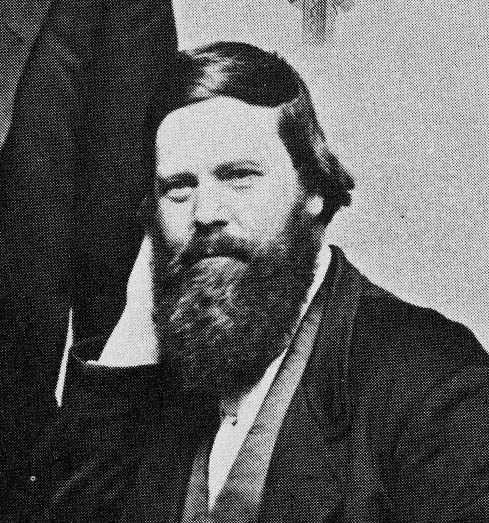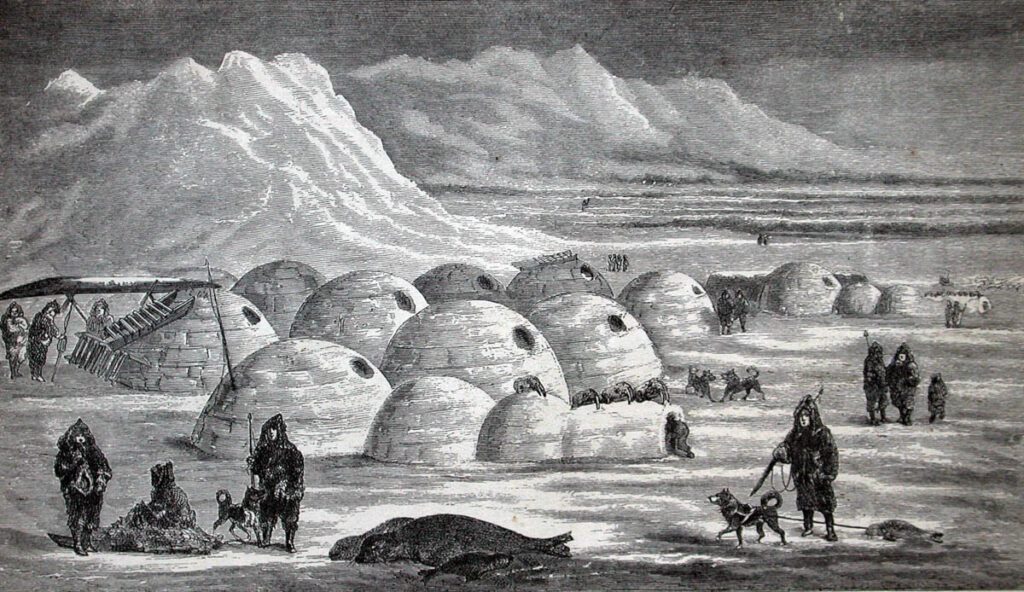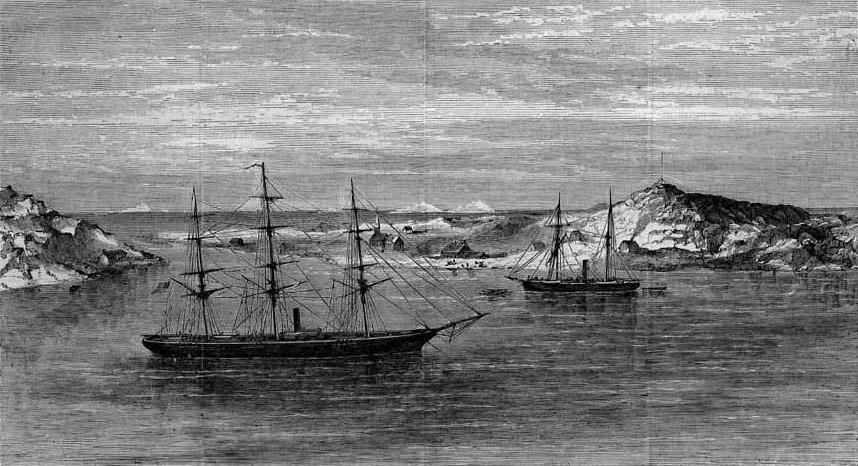
Charles Francis Hall (c. 1821 – November 8, 1871) was an American Arctic explorer. He is best known for his collection of Inuit testimony regarding the 1845 Franklin Expedition and the suspicious circumstances surrounding his death while leading the American-sponsored Polaris expedition in an attempt to reach the North Pole first. The expedition was marred by insubordination, incompetence, and ineffective leadership.
Hall returned to the ship after an exploratory sledging trip and promptly became ill. Before dying, he accused members of the crew, particularly the expedition’s lead scientist, Emil Bessels, of poisoning him. An exhumation of his body in 1968 revealed that he had consumed a significant amount of arsenic in the last two weeks of his life.
Early Life
Little is known about Hall’s early life. He was born in either Rochester, New Hampshire, or Vermont before moving to Rochester at a young age and becoming apprenticed to a blacksmith there.
He married in the 1840s and moved west, eventually settling in Cincinnati in 1849 and starting a business making seals and engraving plates. He later launched his own newspaper, the Cincinnati Occasional, which was later renamed the Daily Press.
Arctic Exploration: First Expedition (1860-1862)
Around 1857, Hall became interested in the Arctic and spent the next few years researching previous explorers’ reports and raising funds for an expedition whose primary goal was to discover the fate of Franklin’s lost expedition.

Hall embarked on his first expedition by boarding the George Henry, a whaler led by Captain Sidney O. Budington out of New Bedford. They made it as far as Baffin Island, where the George Henry was forced to stay the winter. Local Inuit informed Hall about relics from Martin Frobisher’s mining venture at Frobisher Bay, and Hall travelled there to inspect them. He was assisted by his newly hired Inuit guides, husband and wife Ipirvik and Taqulittuq.
Hall also discovered what he believed to be evidence that some of the members of Franklin’s lost expedition were still alive. When he returned to New York, Hall arranged for Harper Brothers to publish his account of the expedition, Arctic Researches and Life Among the Esquimaux. It was edited by William Parker Snow, who was equally obsessed with Franklin’s fate. The two eventually had a disagreement, owing primarily to Snow’s slow editing. Snow later claimed that Hall used his ideas for the Franklin search without giving him credit.
Arctic Exploration :Second Expedition (1863-1869)
Over the course of 1863, Hall planned a second expedition to gather more information about Franklin’s fate, including efforts to locate any rumoured survivors or their written accounts. The first attempt, with the 95-ton schooner USRC Active, was abandoned, most likely due to financial constraints caused by the American Civil War and a strained relationship with his intended second-in-command, William Parker Snow. Finally, in July 1864, a much smaller expedition departed aboard the whaler Monticello.
During his second expedition to King William Island, Hall discovered remains and artifacts from the Franklin expedition and inquired further about their fate from natives who lived there. Hall eventually came to believe that the stories of survivors were unreliable, whether by the Inuit or his.
On July 31, 1868, while in Repulse Bay, Hall shot Patrick Coleman, a whaler in his party, claiming that Coleman, who was unarmed, was attempting mutiny. Other whalers in the party claimed the attack took place because Hall was upset that Coleman was interviewing local Inuit without his permission. Coleman died two weeks after being shot, and Hall expressed remorse and attempted to heal him. Hall was never tried for Coleman’s murder because the Canadian government considered it under American jurisdiction, and the American government completely ignored the case. Two days after Coleman’s death, the whaling ships Ansel Gibbs and Concordia arrived at Repulse Bay. The remaining four whalers deserted these ships, leaving Hall with the Inuit.

Polaris expedition (1871-1873)
Hall’s third expedition had a completely different character. He received a $50,000 grant from the United States Congress to lead an expedition to the North Pole aboard the USS Polaris. The 25-person party also included Hall’s old friend Budington as sailing master, George Tyson as navigator, and Emil Bessels as physician and chief of scientific staff. The expedition was doomed from the start when the party split into rival factions. A large portion of the party resented Hall’s authority over the expedition, and discipline broke down.
Death
On September 10, 1871, Polaris sailed into Thank God Harbour (now Hall Bay) and anchored for the winter on the northern Greenland shore. That fall, while returning to the ship from a sledging expedition with an Inuit guide to a fjord named Newman Bay, Hall became ill after drinking a cup of coffee. He collapsed in what was called a fit. He experienced vomiting and delirium for the next week before appearing to improve for a few days. At the time, he accused several of the ship’s crew, including Bessels, of poisoning him. Hall died on November 8 and was brought ashore and given a proper burial.
Budington took command of the expedition, which was reorganized in June 1872 to try for the Pole. This was ineffective, and Polaris turned south. On October 12, the ship was surrounded by ice in Smith Sound and was about to be crushed. Nineteen of the crew and Inuit guides abandoned the ship for the surrounding ice, while 14 remained on board. On October 24, the Polaris ran aground near Etah and was crushed. After wintering on land, the crew sailed south in two boats and were rescued by a whaler before returning home via Scotland.
The following year, the rest of the party attempted to separate Polaris from the pack and travel south. In the fall of 1872, the pack broke up violently and threatened to crush the ship, separating a group that included Tyson. The group of 19 drifted over 1,500 miles (2,400 km) on an ice floe for six months before being rescued off the coast of Newfoundland by the sealer Tigress on April 30, 1873, and most likely would have perished if the group had not included several Inuit who were able to hunt for the party.
Aftermath and Investigation
The official investigation that followed determined that Hall died of apoplexy. However, in 1968, Hall’s biographer, Chauncey C. Loomis, a professor at Dartmouth College, led an expedition to Greenland to exhume his body. To the professor’s advantage, permafrost had preserved the body, flag shroud, clothing, and coffin. Tests on tissue samples of bone, fingernails, and hair revealed that Hall died from arsenic poisoning in the last two weeks of his life.
This diagnosis is consistent with the symptoms that party members reported. Arsenic was a common ingredient in quack medicines at the time, so Hall may have treated himself with the poison. Loomis suspected that he was murdered by one of the other expedition members, possibly Bessels, but no charges were ever filed. Most recently, the discovery of affectionate letters written by both Hall and Bessels to Vinnie Ream, a young sculptor they met in New York while waiting for the Polaris to be outfitted, suggests a possible motivation for Bessels to kill Hall.






